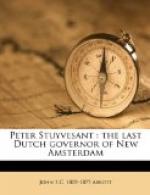“how cheerful the repast, its memory must ever have been fraught with sadness to both host and guests. It was the last occasion of Andre’s meeting his comrades in life. Four short days gone, the hands, then clasped by friendship, were fettered by hostile bonds. Yet nine days more and the darling of the army, the youthful hero of the hour, had dangled from a gibbet.”
For two hundred and twelve years this mansion of venerable memories remained. Then it was swept away by the resistless tide of an advancing population. The thronged pavements of Thirty-fifth street now pass over the spot, where two centuries ago the most illustrious men crowded the banqueting hall, and where youth and beauty met in the dance and song. In view of these ravages of time, well may we exclaim in the impressive words of Burke, “What shadows we are and what shadows we pursue.”
In the year 1774, John Adams rode from Boston to Philadelphia on horseback, to attend the first meeting of Congress. His journal contains an interesting account of this long and fatiguing tour. Coming from the puritanic simplicity of Boston, he was evidently deeply impressed with the style and splendor which met his eye in New York. In glowing terms he alludes to the elegance of their mode of living, to the architectural grandeur of their country seats; to the splendor of Broadway, and to the magnificent new church they were building, which was to cost one hundred thousand dollars.
The aristocratic families of New York were generally in favor of the Crown. They were not disposed to pay any special attention to a delegate to the democratic Congress. He had therefore no opportunity of witnessing the splendor of these ancient families. Two lawyers who had become wealthy by their professional labors, received him with honor. At their breakfast tables he beheld display, common enough in almost every genteel household at the present day, but to which he was quite unaccustomed in his frugal home at Quincy. One cannot but be amused in reading the following description of one of his entertainments:
“A more elegant breakfast I never saw; rich plate; a very large silver coffee pot; a very large silver tea pot; napkins of the very finest materials; toast and bread and butter in great perfection. After breakfast a plate of beautiful peaches, another of pears and a muskmelon were placed on the table.”
The Revolution proved the utter ruin of these great landed proprietors, who naturally espoused the cause of the British court. The habits of life to which they and their fathers had been accustomed necessarily rendered all the levelling doctrines of the Revolution offensive to them. They rallied around the royal banners and went down with them.
Some few of the landed proprietors espoused the cause of the people. Among others may be mentioned the Livingstons and the Schuylers, the Jays, the Laurences, and a portion of the Van Courtlands, and of the Morris family. Fortunately for the Patroon Van Rensselaer, he was a minor, and thus escaped the peril of attaching himself to either party.




